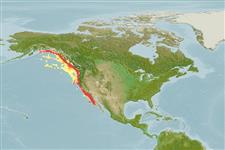Common names from other countries
Myxines (hagfishes) >
Myxiniformes (Hagfishes) >
Myxinidae (Hagfishes) > Eptatretinae
Etymology: Eptatretus: hepta (Gr.), seven; tretos (Gr.), perforated (i.e., with holes), referring to seven gill apertures on what would later be described as Homea banksii (=E. cirrhatus) [range within genus is 6-14 pairs of gill apertures]. (See ETYFish); deani: In honor of American ichthyologist Bashford Dean (1867-1928), American Museum of Natural History, for his work on the embryology of E. stoutii. (See ETYFish).
More on authors: Evermann & Goldsborough.
Environment: milieu / climate zone / depth range / distribution range
Écologie
marin bathydémersal; non migrateur; profondeur 103 - 2743 m (Ref. 31276). Deep-water; 60°N - 27°N, 148°W - 114°W
Eastern Pacific: southeastern Alaska to central Baja California, Mexico.
Length at first maturity / Taille / Poids / Âge
Maturity: Lm 38.0 range ? - ? cm
Max length : 63.5 cm TL mâle / non sexé; (Ref. 96339)
Épines dorsales (Total) : 0; Rayons mous dorsaux (Total) : 0; Épines anales: 0; Rayons mous anaux: 0. No true fins - one dorsal finfold, far back, median, very low, continuous with the caudal; caudal moderately broad, and round with ray-like markings; ventral finfold very low, origin somewhat posterior to last gill aperture, extending to anus (Ref. 6885). Prune colored, preserved specimens black; frequently piebald with light spots; the very edges of caudal and ventral finfolds may be light colored (Ref. 6885).
Inhabits mud bottoms (Ref. 2850). Minimum depth reported at 103 m (Ref. 80811).
Copulatory organ absent. The gonads of hagfishes are situated in the peritoneal cavity. The ovary is found in the anterior portion of the gonad, and the testis is found in the posterior part. The animal becomes female if the cranial part of the gonad develops or male if the caudal part undergoes differentiation. If none develops, then the animal becomes sterile. If both anterior and posterior parts develop, then the animal becomes a functional hermaphrodite. However, hermaphroditism being characterised as functional needs to be validated by more reproduction studies (Ref. 51361 ). In one study (Ref. 40710), hermaphroditism is exhibited by only 0.2% of the individuals examined.
Fernholm, B., 1998. Hagfish systematics. p. 33-44. In J.M. Jørgensen, J.P. Lomholt, R.E. Weber and H. Malte (eds.) The biology of hagfishes. Chapman & Hall, London. 578 p. (Ref. 31276)
Statut dans la liste rouge de l'IUCN (Ref. 130435)
CITES (Ref. 128078)
Not Evaluated
Menace pour l'homme
Harmless
Utilisations par l'homme
Pêcheries: sans intérêt
Outils
Articles particuliers
Télécharger en XML
Sources Internet
Estimates based on models
Preferred temperature (Ref.
115969): 3.2 - 5.5, mean 4.3 (based on 54 cells).
Phylogenetic diversity index (Ref.
82804): PD
50 = 0.5000 [Uniqueness, from 0.5 = low to 2.0 = high].
Bayesian length-weight: a=0.00234 (0.00139 - 0.00396), b=2.93 (2.78 - 3.08), in cm Total Length, based on LWR estimates for this species & (Sub)family-body (Ref.
93245).
Niveau trophique (Ref.
69278): 3.8 ±0.52 se; based on food items.
Résilience (Ref.
120179): Faible, temps minimum de doublement de population : 4,5 à 14 années (Fec = 14).
Fishing Vulnerability (Ref.
59153): Moderate to high vulnerability (45 of 100).
